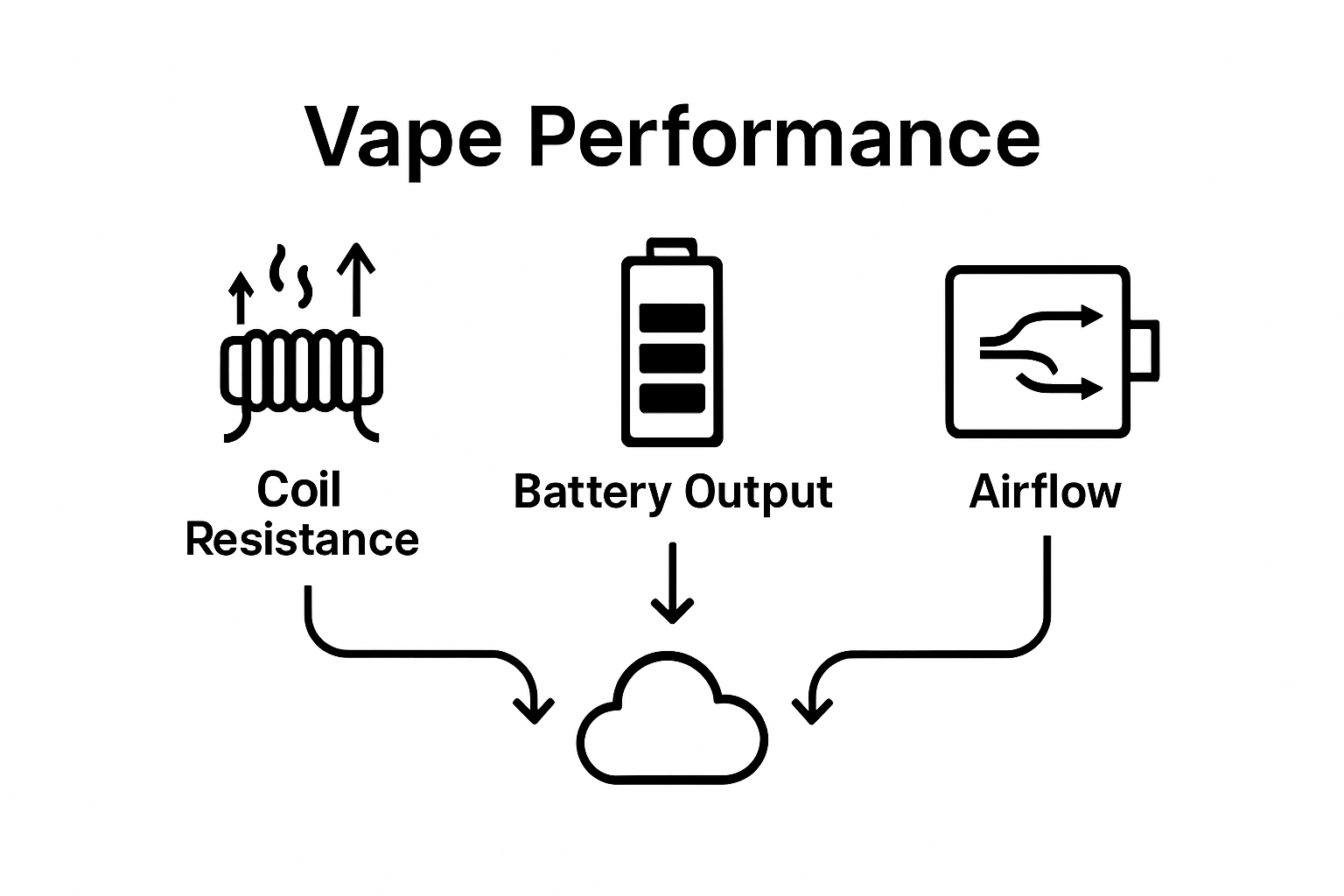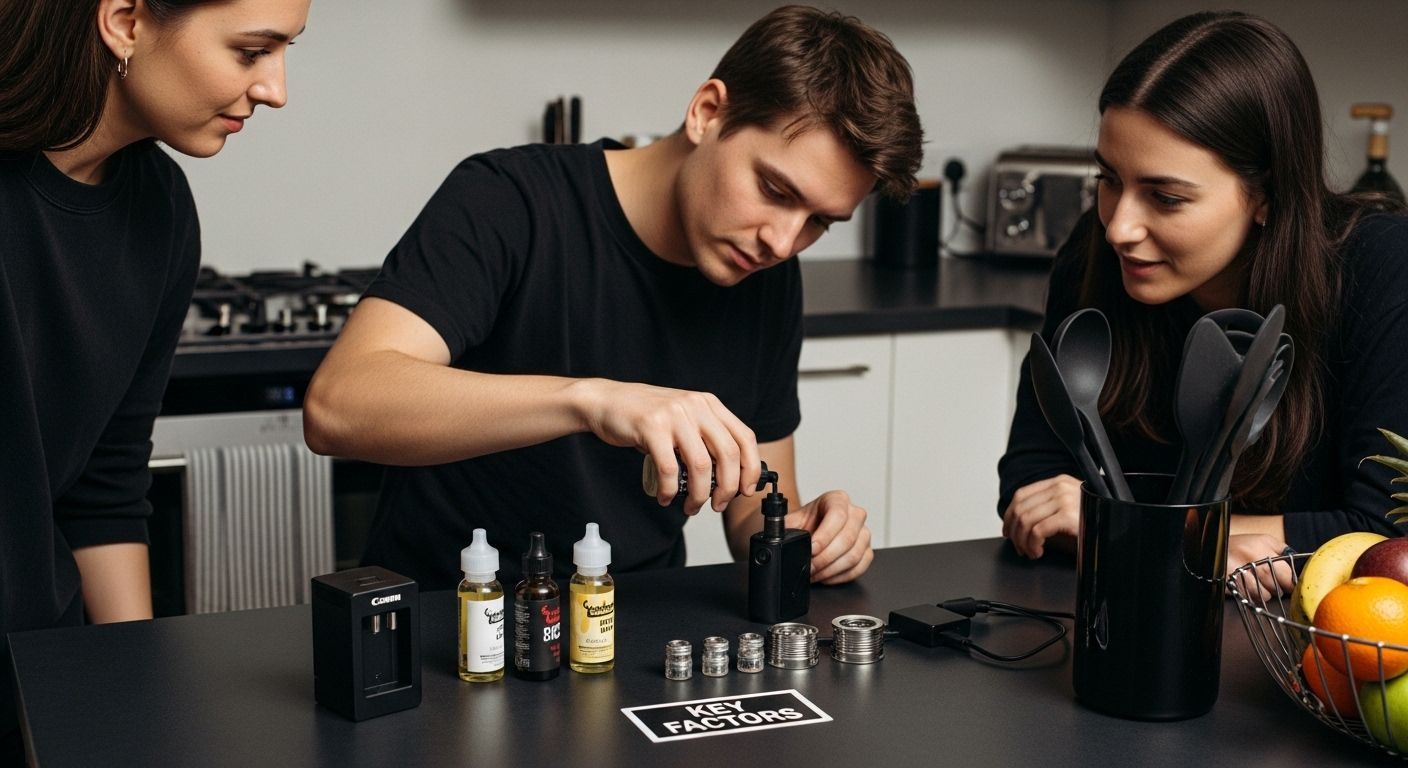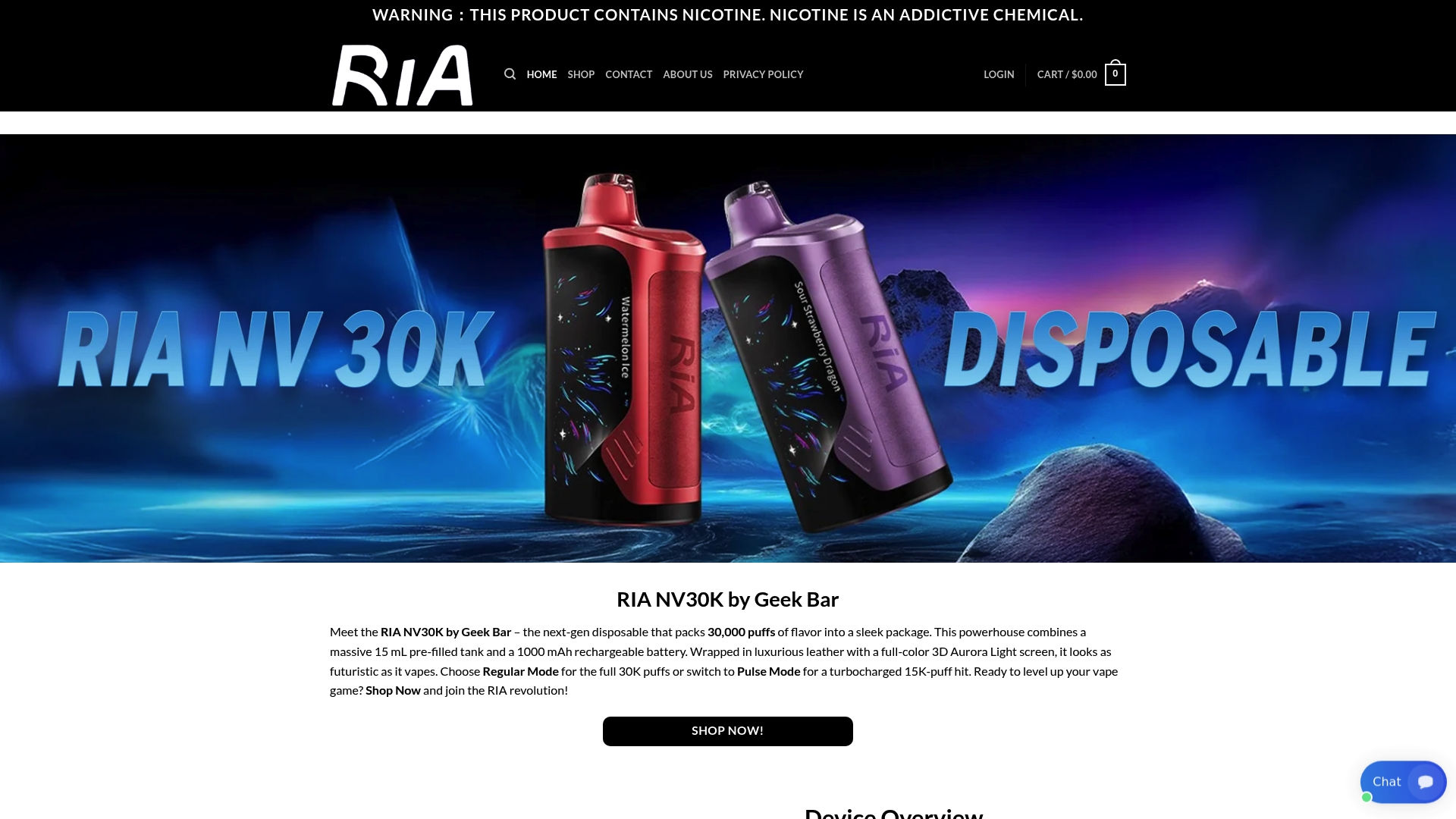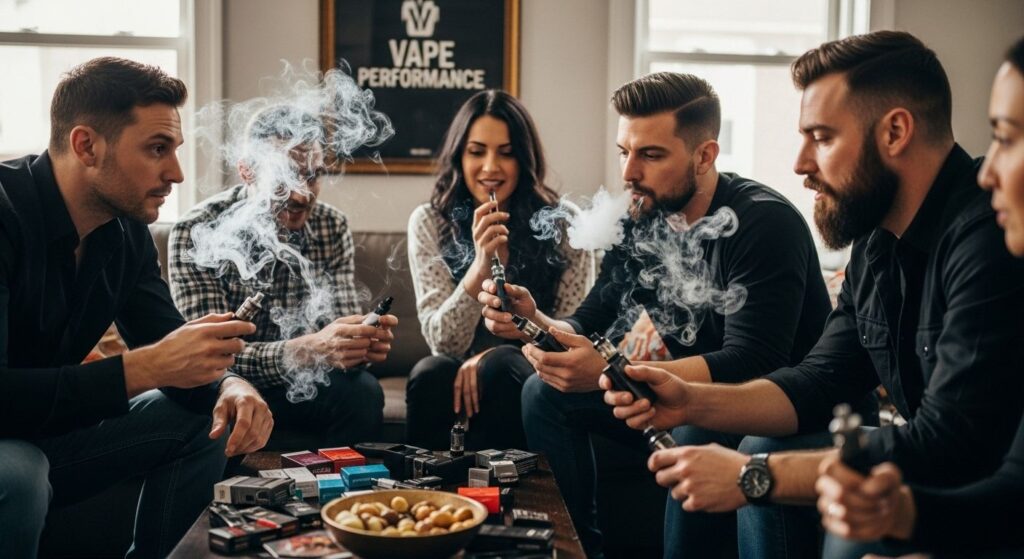Blog
Understanding Factors Affecting Vape Performance
Vape performance is more than just thick clouds or bold flavors. In fact, higher power settings can spike carbonyl emissions and may even create harmful chemicals like formaldehyde. Most people focus on vapor and taste, but the real story is how advanced battery tech and precision engineering work together behind the scenes. You might be surprised by how these hidden details have a much bigger impact on safety and satisfaction than you think.
Table of Contents
- What Is Vape Performance And Why It Matters
- Key Factors Influencing Vape Performance
- The Role Of E-Liquid Composition In Vaping
- Hardware Design And Its Impact On Performance
- Understanding Battery And Power Management In Vapes
Quick Summary
| Takeaway | Explanation |
|---|---|
| Vape performance impacts user satisfaction. | Higher performance leads to improved flavor and nicotine delivery, enhancing the overall vaping experience. |
| Key performance indicators include vapor production. | Essential metrics like vapor volume and flavor consistency help assess device quality and efficiency. |
| E-liquid composition significantly affects performance. | Ratios of PG and VG influence vapor density and throat hit, impacting the sensory experience. |
| Hardware design is crucial for efficiency. | Elements like coil configuration and airflow design ensure optimal vapor production and user comfort. |
| Advanced battery management enhances safety. | Intelligent systems monitor temperature and charge, preventing overheating and ensuring reliable device operation. |
What is Vape Performance and Why It Matters
Vape performance represents the overall quality, efficiency, and user experience delivered by an electronic vaping device. It encompasses multiple technical and experiential factors that determine how effectively a vaping device converts e-liquid into vapor, delivers nicotine, and satisfies user preferences. Our comprehensive guide on device technology explores these intricate details.
Understanding Core Performance Parameters
At its fundamental level, vape performance is evaluated through several critical parameters. According to research published in Tobacco Induced Diseases, key performance indicators include:
- Vapor Production: The volume and density of vapor generated per puff
- Flavor Consistency: The ability to maintain consistent taste quality throughout device usage
- Nicotine Delivery Efficiency: How effectively the device transfers nicotine from e-liquid to user
- Battery Performance: Power output, recharge speed, and overall battery longevity
Why Performance Matters for Users
Performance directly impacts user satisfaction and experience. A high-performing vaping device ensures smoother draws, more accurate flavor representation, consistent nicotine absorption, and reliable operational functionality. Poor performance can lead to uneven vapor production, burnt tastes, inconsistent nicotine delivery, and shortened device lifespan.
Advanced users and enthusiasts particularly appreciate devices that demonstrate superior technical capabilities. They seek vaping systems that offer precise control, advanced technological features, and reliable performance across different usage scenarios. The intersection of engineering precision and user experience defines what makes a truly exceptional vaping device.
Understanding vape performance helps users make informed decisions, selecting devices that align with their specific preferences, usage patterns, and desired vaping experience.
Key Factors Influencing Vape Performance
Vape performance is a complex interplay of technological and design elements that determine the overall quality of the vaping experience. Multiple interconnected factors contribute to how effectively a device transforms e-liquid into satisfying vapor. Our technical specifications guide provides deeper insights into these intricate relationships.
Technical Components Affecting Performance
According to research in Tobacco Control, several critical technical components significantly impact vape performance
 :
:
- Coil Resistance: Determines heating efficiency and vapor production
- Battery Power Output: Controls temperature and consistent energy delivery
- Airflow Design: Influences vapor density and draw smoothness
- E-Liquid Composition: Affects flavor intensity and nicotine delivery
Crucial Performance Determinants
The interaction between hardware design and e-liquid properties creates a complex performance ecosystem. Coil quality plays a pivotal role in determining long-term device functionality. Higher quality coils maintain consistent resistance levels, preventing performance degradation and ensuring reliable vapor production.
Battery technology represents another fundamental performance factor. Advanced lithium-ion batteries with sophisticated power management systems enable more precise temperature control, longer usage times, and more consistent nicotine delivery. Modern devices integrate intelligent chipsets that dynamically adjust power output to optimize user experience.
E-liquid viscosity and nicotine concentration also dramatically influence performance. Thinner liquids tend to produce more vapor, while higher nicotine concentrations can impact flavor complexity and throat hit. Professional vapers often experiment with different liquid formulations to find their optimal performance profile.
Understanding these interconnected factors empowers users to make informed decisions, selecting devices that align with their specific preferences and performance expectations.

The Role of E-Liquid Composition in Vaping
E-liquid composition represents the fundamental blueprint that determines the overall vaping experience, influencing everything from flavor profile to vapor production. Explore our comprehensive flavor guide to understand these nuanced interactions.
Core Liquid Components
According to research in Frontiers in Physiology, e-liquid typically consists of four primary ingredients:
- Propylene Glycol (PG): Thin liquid that carries flavor and provides throat hit
- Vegetable Glycerin (VG): Thick liquid responsible for dense vapor production
- Nicotine: Active ingredient with variable concentration levels
- Flavorings: Chemical compounds creating taste diversity
Performance Impact of Ingredient Ratios
The precise ratio of these components dramatically transforms vaping performance. PG/VG ratios are particularly critical. Higher PG concentrations create a sharper throat sensation and more pronounced flavor intensity, while higher VG ratios generate substantially more vapor volume with smoother inhale characteristics.
Nicotine concentration introduces another layer of complexity. Lower nicotine levels typically provide smoother draws and more nuanced flavor experiences. Conversely, higher nicotine concentrations deliver more pronounced throat hits and faster nicotine absorption, catering to users seeking more intense experiences.
Flavor compounds represent the most variable element in e-liquid composition. Different molecular structures interact uniquely with PG and VG, creating complex sensory experiences. Some flavoring agents enhance vapor production, while others might slightly reduce overall performance. Advanced manufacturers carefully engineer these interactions to optimize taste, smoothness, and cloud production.
Understanding e-liquid composition empowers users to customize their vaping experience, selecting formulations that precisely match their preferences for flavor, vapor density, and nicotine delivery.
The table below summarizes the core components of e-liquid and how their ratios affect vaping performance, helping users understand how to customize their experience.
| Component | Description | Impact on Performance |
|---|---|---|
| Propylene Glycol (PG) | Thin liquid that carries flavor and provides throat hit | Sharper throat sensation, more flavor intensity |
| Vegetable Glycerin (VG) | Thick liquid responsible for dense vapor production | Greater vapor volume, smoother inhale |
| Nicotine | Active ingredient, variable concentration | Stronger throat hit, faster absorption at higher levels |
| Flavorings | Chemical compounds for taste diversity | Can enhance or slightly reduce vapor/flavor |
Hardware Design and Its Impact on Performance
Hardware design represents the critical architectural foundation that determines a vaping device’s overall performance, efficiency, and user experience. Learn more about our advanced device technologies to understand these intricate engineering principles.
Critical Hardware Performance Elements
According to research analyzing electronic nicotine delivery systems, several fundamental hardware components critically influence vaping performance:
- Heating Coil Configuration: Determines temperature control and vapor generation
- Airflow Mechanism: Regulates draw resistance and vapor density
- Battery Management System: Controls power delivery and temperature stability
- Material Quality: Impacts durability and consistent performance
Engineering Precision in Device Design
Coil engineering sits at the heart of vaping hardware performance. Advanced coil designs utilize sophisticated materials like kanthal, nichrome, and mesh, each offering unique heating characteristics. The coil’s resistance, wire thickness, and structural geometry directly impact heat distribution, vapor production, and flavor intensity.
Battery technology represents another pivotal performance determinant. Modern devices integrate intelligent power management systems that dynamically adjust voltage and wattage. These systems prevent overheating, optimize energy efficiency, and provide consistent power delivery across different usage scenarios.
Airflow design introduces another layer of performance complexity. Precision-engineered airflow channels control draw resistance, vapor temperature, and overall inhalation experience. Manufacturers calibrate these channels to create specific sensory experiences, balancing between tight, restrictive draws and open, cloud-producing configurations.
Understanding hardware design empowers users to appreciate the sophisticated engineering behind modern vaping devices, recognizing that performance is the result of meticulous technological integration.
This table organizes the key hardware components and design elements that influence vape performance, making it easier to compare their roles and effects on user experience.
| Hardware Element | Function | Performance Impact |
|---|---|---|
| Heating Coil Configuration | Controls heat and vapor production | Affects temperature, vapor volume, flavor |
| Airflow Mechanism | Regulates draw resistance and vapor density | Alters inhalation feel, vapor thickness |
| Battery Management System | Maintains stable power and temperature | Ensures consistent output, prevents overheating |
| Material Quality | Determines durability of device components | Influences device lifespan, consistent function |
Understanding Battery and Power Management in Vapes
Battery and power management represent the technological backbone of modern vaping devices, determining performance, safety, and overall user experience. Learn more about our advanced battery technologies to understand these critical engineering principles.
Battery Technology Fundamentals
According to research from the American Heart Association, battery design critically influences device performance through several key parameters:
- Battery Chemistry: Determines energy density and discharge characteristics
- Voltage Regulation: Controls consistent power delivery
- Temperature Management: Prevents overheating and potential safety risks
- Charging Infrastructure: Impacts overall device longevity and reliability
Power Management Strategies
Intelligent power management transforms vaping device performance. Modern lithium-ion batteries integrate sophisticated microcontrollers that dynamically adjust voltage and wattage. These systems continuously monitor battery temperature, remaining charge, and power draw, preventing potential safety issues while optimizing energy efficiency.
Voltage and resistance interactions play a crucial role in vapor production. Higher power settings generate more heat, increasing vapor volume and flavor intensity. However, excessive power can lead to unintended consequences. Research indicates that increasing device power output can elevate carbonyl emissions, potentially generating harmful compounds like formaldehyde and acetaldehyde.
Advanced devices now incorporate multiple safety features such as short-circuit protection, low voltage cutoff, and thermal management systems. These technologies protect users by preventing battery overheating, managing power consumption, and ensuring consistent performance across different usage scenarios.
Understanding battery and power management empowers users to make informed decisions, balancing performance preferences with device safety and longevity.
Tired of Inconsistent Vape Performance? Discover Precision and Power with RIA NV30K
If you have ever struggled with issues like inconsistent vapor production, flavor loss, or battery life that just does not keep up, you are not alone. The article explains how coil resistance, advanced battery management, airflow, and e-liquid ratios all play a critical role in your vaping experience. Many users face these frustrations, wanting a device that delivers reliable performance, full flavor, and lasting satisfaction from the first puff to the last.

Make the switch to a smarter vape choice today. The RIA NV30K disposable device takes all those key factors and wraps them into one powerful, high-capacity solution. Engineered with a rechargeable battery, pre-filled large tank, and luxury design, it is crafted to solve the performance problems discussed in the article. Do not settle for less when you can experience smooth draws, rich flavor, and up to 30,000 puffs. Ready to transform your daily vaping routine? Visit our homepage for product details and get yours now. Learn more about what sets us apart in device innovation on our About Us page.
Frequently Asked Questions
What factors influence vape performance?
Vape performance is influenced by several key factors, including coil resistance, battery power output, airflow design, and e-liquid composition. These elements determine how effectively a device produces vapor, delivers flavor, and provides nicotine satisfaction.
How does e-liquid composition affect vaping experience?
The composition of e-liquid, including the balance of propylene glycol (PG), vegetable glycerin (VG), nicotine concentration, and flavorings, directly impacts the vaping experience. Different ratios can affect vapor production, throat hit, and flavor intensity, allowing users to customize their experience.
What role does battery management play in vape performance?
Battery management is crucial for maintaining consistent power delivery and preventing overheating. Intelligent power management systems in modern vapes regulate voltage and wattage, optimizing performance while ensuring safety and longevity of the device.
How can I choose the right vape device for my preferences?
To select the right vape device, consider factors such as desired vapor production, flavor intensity, and nicotine delivery efficiency. Understanding the specifications of different devices, such as coil quality and airflow design, will help you find one that matches your individual vaping style.

